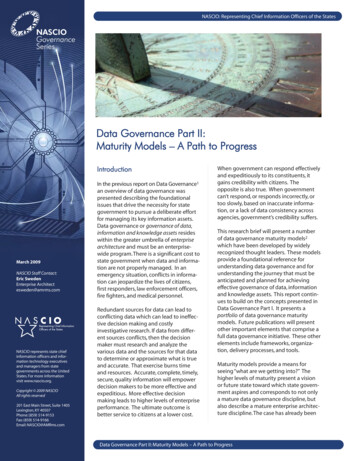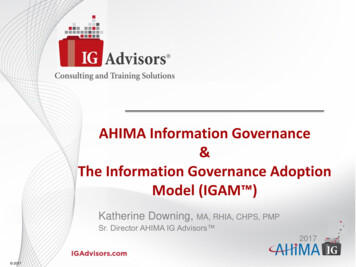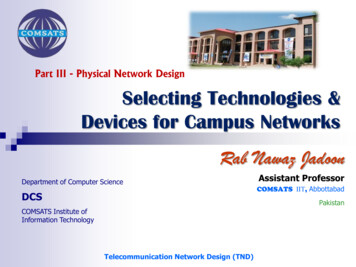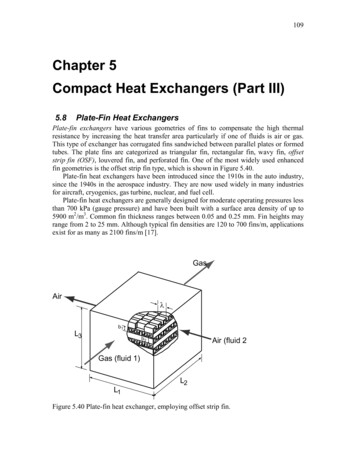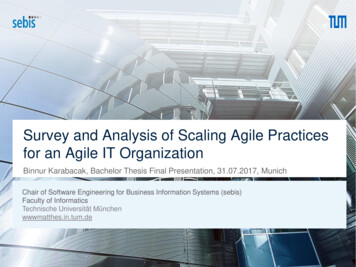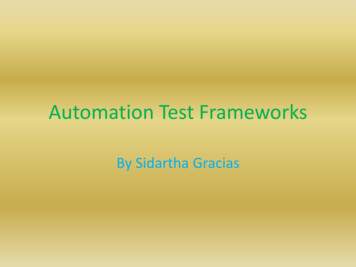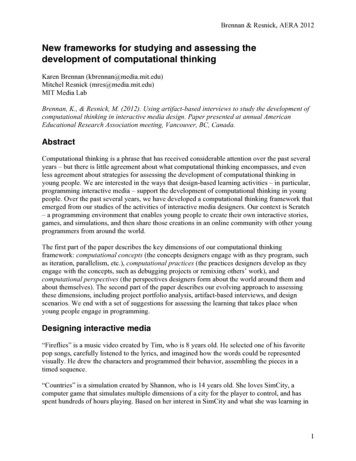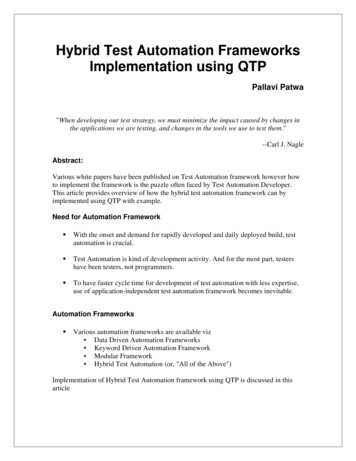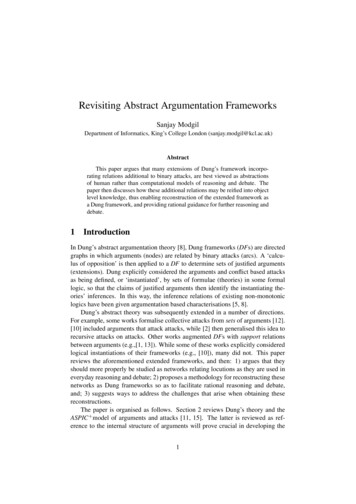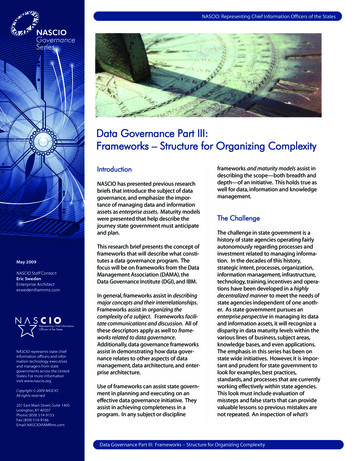
Transcription
NASCIO: Representing Chief Information Officers of the StatesData Governance Part III:Frameworks – Structure for Organizing ComplexityIntroductionNASCIO has presented previous researchbriefs that introduce the subject of datagovernance, and emphasize the importance of managing data and informationassets as enterprise assets. Maturity modelswere presented that help describe thejourney state government must anticipateand plan.May 2009NASCIO Staff Contact:Eric SwedenEnterprise Architectesweden@amrms.comNASCIO represents state chiefinformation officers and information technology executivesand managers from stategovernments across the UnitedStates. For more informationvisit www.nascio.org.Copyright 2009 NASCIOAll rights reserved201 East Main Street, Suite 1405Lexington, KY 40507Phone: (859) 514-9153Fax: (859) 514-9166Email: NASCIO@AMRms.comThis research brief presents the concept offrameworks that will describe what constitutes a data governance program. Thefocus will be on frameworks from the DataManagement Association (DAMA), theData Governance Institute (DGI), and IBM.In general, frameworks assist in describingmajor concepts and their interrelationships.Frameworks assist in organizing thecomplexity of a subject. Frameworks facilitate communications and discussion. All ofthese descriptors apply as well to frameworks related to data governance.Additionally, data governance frameworksassist in demonstrating how data governance relates to other aspects of datamanagement, data architecture, and enterprise architecture.Use of frameworks can assist state government in planning and executing on aneffective data governance initiative. Theyassist in achieving completeness in aprogram. In any subject or disciplineframeworks and maturity models assist indescribing the scope—both breadth anddepth—of an initiative. This holds true aswell for data, information and knowledgemanagement.The ChallengeThe challenge in state government is ahistory of state agencies operating fairlyautonomously regarding processes andinvestment related to managing information. In the decades of this history,strategic intent, processes, organization,information management, infrastructure,technology, training, incentives and operations have been developed in a highlydecentralized manner to meet the needs ofstate agencies independent of one another. As state government pursues anenterprise perspective in managing its dataand information assets, it will recognize adisparity in data maturity levels within thevarious lines of business, subject areas,knowledge bases, and even applications.The emphasis in this series has been onstate wide initiatives. However, it is important and prudent for state government tolook for examples, best practices,standards, and processes that are currentlyworking effectively within state agencies.This look must include evaluation ofmissteps and false starts that can providevaluable lessons so previous mistakes arenot repeated. An inspection of what’sData Governance Part III: Frameworks – Structure for Organizing Complexity
NASCIO: Representing Chief Information Officers of the Statesalready there can provide valuable inputinto the state wide data governanceprograms.EnterpriseInformationManagement (EIM):An operationalcommitment todefine, secure,maintain andimprove the integrityand efficiency ofinformation assetsacross businessboundaries, thusachieving key objectives of anorganization’s enterprise informationarchitecture strategy.2GartnerThere has been progress in gaining anenterprise perspective over the past decade.Ten years ago a request for criminal historyinformation would most likely have metwith a different response than it wouldtoday. Today, the relevance of criminalhistory information to hiring decisions,education credentialing and custodydecision making is well understood. Stategovernment is designing and implementing collaborative information exchangesthat entail all government lines of businessthat historically did not share information.Further discussion of the issues of information sharing is presented in the NASCIOreport “Perspectives - GovernmentInformation Sharing: Calls to Action.”1Examples of collaborative informationexchange partners include: justice andhomeland security; justice and publichealth; justice and environmental; transportation and environmental; correctionsand healthcare providers. The recognitionof cross line of business collaborativeinformation exchanges has created newdemand and opportunities for more effective government decision making. It hasalso brought to light the disparity in dataterms, definitions, and implementations.Now state government must develop itscapability for managing enterprise dataand information and that is where thedisciplines of data and knowledgemanagement become relevant.Organizations in all sectors have recognized the necessity of viewing informationas an enterprise asset as demonstrated bythe advent of Enterprise InformationManagement (EIM) initiatives.Previous development of point solutionsand “silos of information” have created ahighly diversified portfolio of processes,data assets, and technologies across stategovernment. Today, it is recognized thatstate agencies can benefit decidedly fromworking collaboratively. Such collaboration then demands the capability to shareinformation easily and quickly. However,2due to the vast complexities created by ahistory of independence, the greatestbarrier to collaborative work relationshipsis the inability to easily share informationacross agency boundaries. As new circumstances arrive that were never anticipated,the ability for state government to work asa single enterprise in meeting these newcircumstances is greatly hindered. Thesecircumstances were created during an erawhen collaboration was not promoted andwas even discouraged. Now state government is seriously challenged in its effortsto treat data and information assets asenterprise assets. Before state governmentcan truly harvest the benefits of sharedservices, SOA, or cloud computing, it mustunderstand and properly manage itsdata/information.State governments are desperatelyseeking ways to begin to manage theirinformation assets actively. The questionsare myriad, but primary is the question ofhow to get started. NASCIO’s series ongovernance is intended to provide thatguidance. First is the recognition thatthere is required governance or oversightthat must be established which recognizesthe decision rights of all stakeholders. Thishas been described in the introductoryresearch brief.3Second is developing an understandingregarding the journey that must be anticipated to achieve a mature datagovernance capability. That journey waspresented in the second in these series.4Now begins a process of examining thebuilding blocks of data and informationmanagement. These include the concepts,organization, and process that compriseinformation management or datamanagement. Anticipating the need forcollaboration, common subject areas thatare shared across state agencies willeventually have to be identified.Data Governance Part III: Frameworks – Structure for Organizing Complexity
NASCIO: Representing Chief Information Officers of the StatesNeed for a Business OutcomeAs an example of a subject area, stateshave selected PERSON and all the varioussubtypes related to it as an obvious candidate for establishing a common, sharedsubject area. Another example is PLACE.These subject areas are excellent startingsubjects for establishing commonality ofdescription and representation acrossstate government data architecture. Ifagencies can agree and share this information, great gains can be achieved forcreating a single state government facetoward the citizen.Embarking on large enterprise wide initiatives has not proven successful historically.A better approach is to begin with a focusarea or business outcome that is beingsought within state government. In theprocess of meeting that business need,parallel ongoing activity can be undertaken to build the enterprise-wide datagovernance capability.As an example of this kind of focus, somestates have pursued data governanceinitiatives related to education. Stategovernment is interested to know ifprimary education is properly preparingelementary students for intermediate,junior high and high school. Are highschool programs adequately preparingstudents for college programs? Arecollege programs adequate for thedemands of the 21st Century economy?How effective is the teaching / trainingprocess? These critical questions form thefocus area and help describe the businessoutcome that drives a need for establishing the necessary data and informationmanagement to continually evaluate theprocess of education. Effective management of information can provide the basisfor understanding that can then lead tothe necessary strategic decision making toensure changes and transformations areinitiated and orchestrated within theprocesses and systems of education.Proper data governance is necessary toguide and sustain effective management ofinformation.The demand for data and information toenable effective state governmentdecision making forms the basis forongoing development of business intelligence capabilities. Such capabilities arerequired to truly understand the problems,challenges, successes, and requirements ofeducation at all levels. With proper intelligence, analysis, and decision making, theeducational process can be continuallyimproved to present relevant, effectivetraining and education outcomes. Further,assumptions can be evaluated and eithervalidated or corrected.As was presented regarding data governance maturity models, there are also avariety of frameworks that deserve reference. Each one brings valuableperspectives and dimensions to stategovernment data governance and datamanagement programs.The Data Management Association(DAMA) framework presents how datagovernance drives other functions thatcomprise an enterprise data managementinitiative. The Data Governance Institute(DGI) Framework provides an overarchingprocess for establishing and sustaining adata governance initiative. The IBM DataGovernance Model has an inherent framework for data governance which waspresented in NASCIO’s research brief ondata governance maturity models. Thisframework presents an emphasis on therelationships among the major groupingsof data governance elements.The Data Management AssociationInternational - DAMADAMA published the Data ManagementBody of Knowledge (DMBOK) in 2009. Thisis the culmination of years of work, andcontributions from an internationalcommunity of data management professionals representing all sectors of theglobal economy. This framework is veryrelevant to NASCIO’s presentation ofgovernance. The DMBOK goes beyondstrictly data governance to dovetail intoData Governance Part III: Frameworks – Structure for Organizing Complexity3
NASCIO: Representing Chief Information Officers of the StatesFIGURE 1: DMBOK eDataQualitythe functions and processes for comprehensive data management. As presentedin earlier NASCIO research briefs, “datamanagement” is the prevailing term.However, DAMA has made it clear that thediscipline of data management is broadenough to include data, information andknowledge. It is expected that over timemore organizational emphasis will begiven to the importance of managingdata, information and knowledge assets.The DMBOK will be a valuable resource forstate government as it pursues moreactively managing these assets. Itprovides detailed contextual diagrams,descriptions, diagrams, and a storehouseof references for each of the 10 functionsthat comprise the DAMA DataManagement Framework.The goals of the DMBOK are focused ondata and knowledge management: Build consensus Provide standard definitions Identify guiding principles Provide an overview of commonlyaccepted good practices Identify common issues Clarify scope and boundaries Provide a guide to other relatedresources4The recurring themes of the DMBOK aredescribed in Figure 1.The DAMA framework is really a set of twoframeworks that encompass data management: a functional framework and anenvironmental element framework. Thecenter cell in the functional frameworkdescribes governance. The placement ofthis cell describes the overarching role ofdata governance—it literally touchesevery aspect of data / informationmanagement. Inspection of the DAMAfunctional framework reveals the components of data management that must beaddressed in a data management operating discipline. DAMA published the DataManagement Body of Knowledge(DMBOK)5 which provides a descriptionand context diagram for each of the 10functions depicted. The DAMA frameworkhas changed somewhat over time. It isexpected that it will continue to change asdata and information managementcontinues to mature.The DAMA Functional and EnvironmentalElement frameworks are described indetail in the Data Management Body ofKnowledge (DMBOK). The two componentframeworks are meant to work together.The core framework is the blue circle—Data Governance Part III: Frameworks – Structure for Organizing Complexity
NASCIO: Representing Chief Information Officers of the StatesFIGURE 2: DAMA Functional Framework ise Data ModelingValue Chain AnalysisRelated Data anagement DataDevelopmentArchitectureIntegrationControlMeta DataDelivery ManagementDatabase Operations Management DataGovernance Acquisition & StorageBackup & RecoveryDataContent MgmtWarehousingRetrieval& BusinessRetentionIntelligenceManagement AcquisitionRecoveryTuningRetentionPurgingData SecurityManagementDocument & ContentManagement AnalysisData ModelingDatabase ning & SupportMonitoring & TuningData Management Functions. Eachfunction within the blue circle iscomprised of the associated elementsfrom the framework of EnvironmentalElements. DAMA created a two dimensional worksheet that demonstrates theinteraction. For each function, the variousenvironmental elements must be defined.The worksheet will be unique for eachenterprise and reflect specific organization, culture, and focus for that enterprise.The implied sequence in the framework ofdata management functions is to beginwith Data Governance, advance to DataArchitecture at 12:00 and move aroundclockwise to Data Quality Management at11:00. Most noteworthy is the importanceof starting with data governance. All otherfunctions are subordinate to that function.Further inspection of the Data Governancefunction will make it clear why thatfunction should drive the others. It iswithin that function that the intent of anenterprise data governance program is Reference &Master DataManagement nAuditingData quality must beconsidered integralto any IT environment.- GartnerExternal CodesInternal CodesCustomer DataProduct DataDimension Mgmtestablished. That governance includes: Strategic business intent – BusinessGoals and Objectives Strategic intent of data management Organization Policies Performance metricsThis approach is consistent with theNASCIO Enterprise Architecture ValueChain which begins with understandingand developing the environmentalcontext, followed by the understanding ofspecific needs and markets under consideration, followed by establishing strategicintent and then enabling that intentthrough capabilities. Data management /knowledge management is a criticalenabling capability as has been emphasized in previous NASCIO research briefson this subject.DAMA pursues this subject further byemphasizing that each data managementfunction must account for what DAMAData Governance Part III: Frameworks – Structure for Organizing Complexity5
NASCIO: Representing Chief Information Officers of the StatesFIGURE 3: DAMA Environmental FrameworkOrganization & Culture Technology Tool CategoriesStandards & ProtocolsSelection CriteriaLearning CurvesCritical Success FactorsReporting StructuresManagement MetricsValues, Beliefs, ExpectationsAttitudes, Styles, PreferencesRituals, Symbols, Heritage Goals & Principles Practices & Techniques Phases, Tasks, StepsDependenciesSequence & FlowUse Case ScenariosTrigger EventsVision & MissionBusiness BenefitsStrategic GoalsSpecific ObjectivesGuiding PrinciplesDeliverables Recognized Best PracticesCommon ApproachesAlternative Techniques Roles & Responsibilities Inputs & OutputsInformationDocumentsDatabasesOther ResourcesIndividual RolesOrganizational RolesBusiness & IT RolesQualifications & Skillscalls environmental elements. These arepresented in Figure 3.DAMA’s Data Management Body ofKnowledge (DMBOK) provides a textualfunctional decomposition of the datamanagement functions. There are 10functions and 102 activities. Each activityis categorized as belonging to one of fourActivity Groups:Planning ActivitiesActivities that set the strategic and tacticalcourse for other data management activities. Planning activities may be performedon a recurring basis.Control ActivitiesSupervisory activities performed on an ongoing basis.Development ActivitiesActivities undertaken within projects andrecognized as part of the systems development lifecycle (SDLC), creating datadeliverables through analysis, design,building, testing and deployment.6Activities Operational ActivitiesService and support activities performedon an on-going basis.Clear strategic intent is established foreach function according to the environmental element Goals and Principles. Eachfunction is further described using acontext diagram. Suppliers, inputs,consumers, outputs, metrics and othercomponents are presented as followsusing the function Data Governance as anexample functional context diagram (seeFigure 4).Governance then touches every aspect ofdata management as demonstrated by itsplacement in the center of the DAMAframework of data management functions(see Figure 5).The Data Governance Institute(DGI)In order to understand the DGI framework,it is helpful to understand the underlyingconceptual relationship among businessData Governance Part III: Frameworks – Structure for Organizing Complexity
NASCIO: Representing Chief Information Officers of the StatesFIGURE 4: DAMA Context Diagram for the Governance FunctionFIGURE 5: DAMA Worksheet – How the Two Frameworks RelateEnvironmental ElementsData Management FunctionsGoals &PrinciplesActivitiesDeliverablesRoles &ResponsibilitiesTechnologyPractices & Organization &TechniquesCultureData GovernanceData Architecture ManagementData DevelopmentDatabase OperationsManagementData Security ManagementReference & Master DataManagementData Warehousing & BusinessIntelligence ManagementDocument & ContentManagementMeta Data ManagementData Quality ManagementData Governance Part III: Frameworks – Structure for Organizing Complexity7
NASCIO: Representing Chief Information Officers of the StatesFIGURE 6: Key Responsibilities in Data Governancefunctions, information and technologythat is promoted by the DGI.DGI has observed that the importance ofdata governance has become a high priority for the business. Some organizationshave moved “information management”functions out of information technologyorganizations and into the business side.The business side then has responsibilityfor managing information in order toachieve its strategic intent. Technology isthen engaged to assist in the management of that information. However,management of information is viewed asprimarily a business responsibility. Theserelationships are demonstrated by theVenn diagram presented. Information isthe linchpin between the business and IT.Data governance is not viewed as an endin itself. Data governance is required toensure data quality which contributestoward effective decision making and delivery o
The IBM Data Governance Model has an inherent frame-work for data governance which was presented in NASCIO’s research brief on data governance maturity models. This framework presents an emphasis on the relationshi

